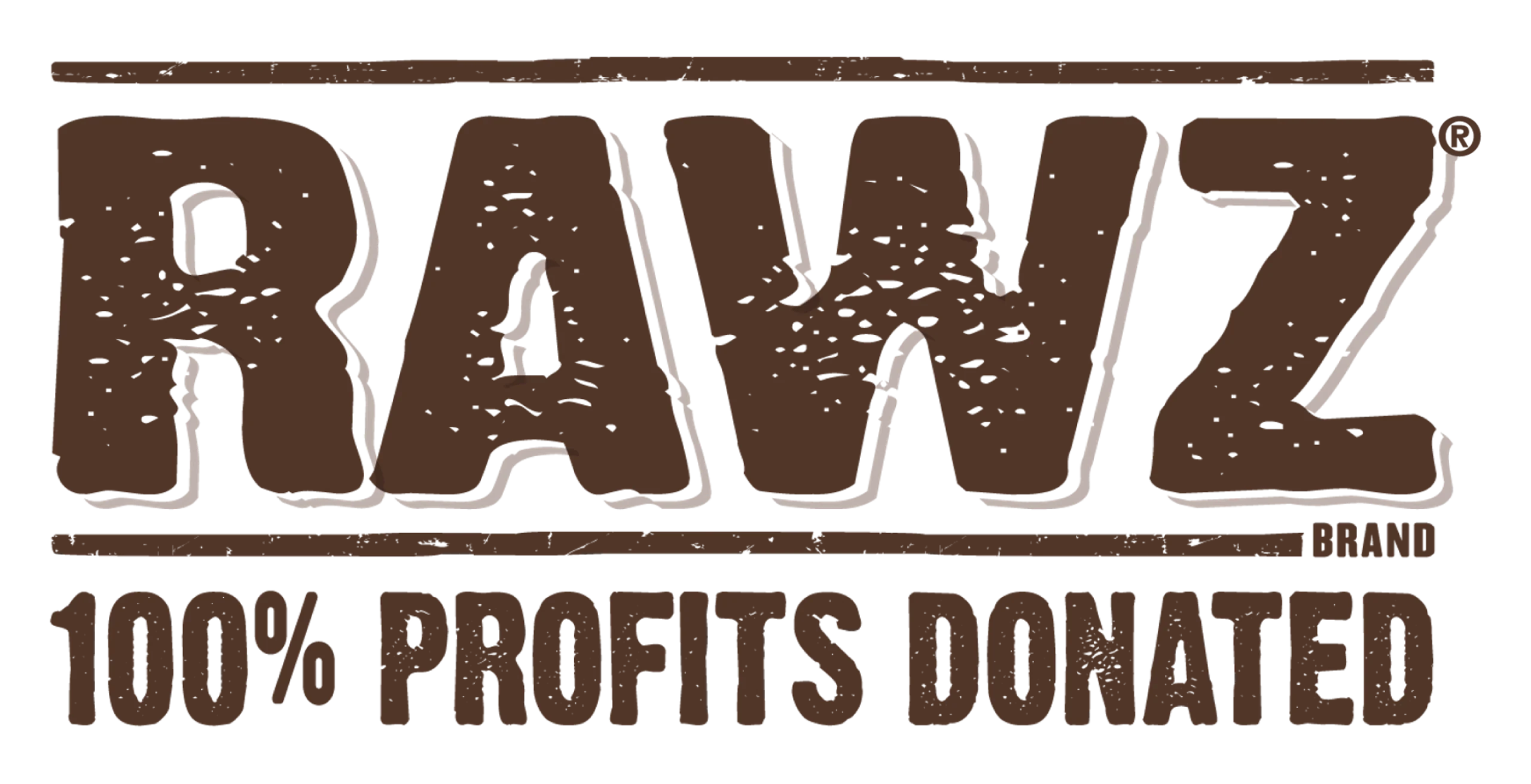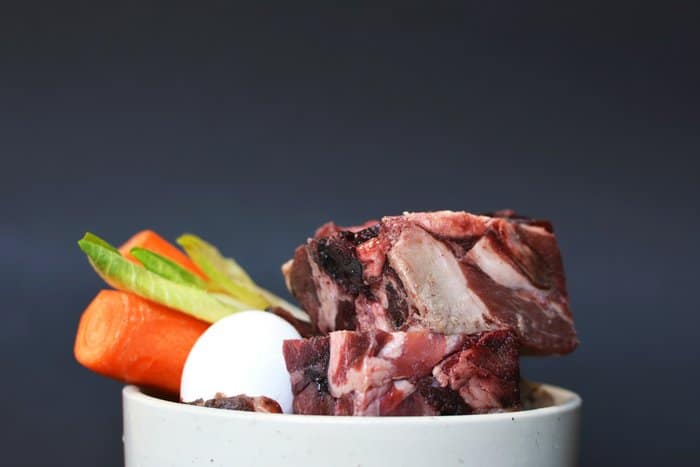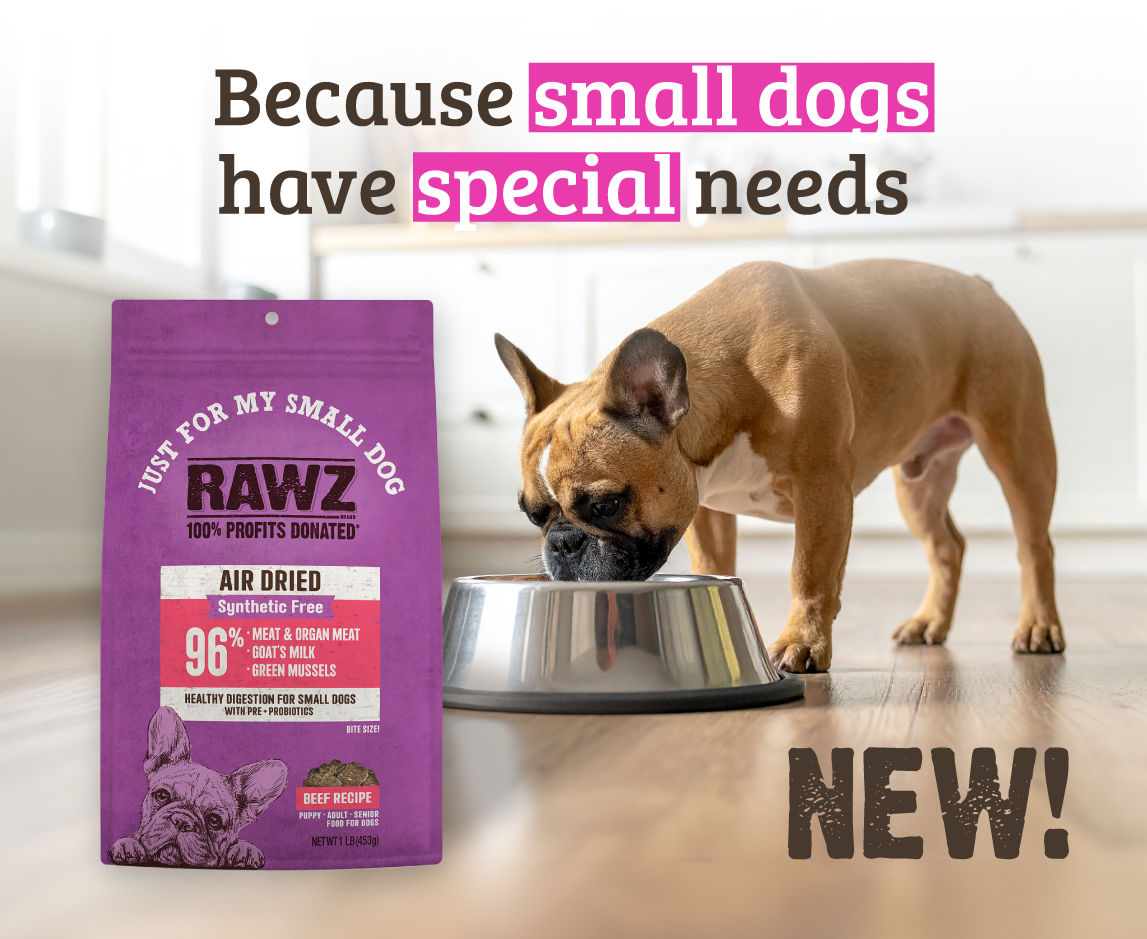The world of pet food is filled with acronyms: AAFCO guidelines, optimal PER, FDA-approved HPP. So what on earth is BARF, and why does it have to sound so unpleasant? The acronym itself has nothing to do with indigestion, and is in fact indicative of what many consider to be the most beneficial approach to feeding your dog.
What is the barf diet for dogs?
BARF stands for “biologically appropriate raw foods,” or “bones and raw foods.” As the name implies, this diet is primarily made up of fresh, raw meat and bones, as well as any combination of the following:
- Fresh produce
- Dairy
- Whole grains
- Vitamin and mineral supplements
A diet based on raw animal proteins is meant to mimic the way a dog might eat in the wild, and contains higher protein levels than most standard commercial pet foods (especially dry formulas). Since almost no part of a raw diet is processed, there are no unnecessary filler ingredients present — and therefore, there’s a far lower chance of your dog having an allergic reaction, developing a food intolerance or gaining weight from excess carbohydrates and fat.
BARF diets have been gaining popularity with dog parents since 1993, when veterinarian Ian Billinghurst published his book Give Your Dog a Bone: The Practical Commonsense Way to Feed Dogs for a Long Healthy Life. Billinghurst’s research, as well as the research of many other veterinarians and animal nutritionists, found that a raw diet can result in improved canine health, better weight management and fewer digestive problems and allergies.
Different Types of Raw Food Diets
In pet food, “raw” is a broad term that can apply to any combination of uncooked and unprocessed ingredients. To be considered truly raw, no part of the formula can be processed using heat, and must always be stored between 32°–42°F until ready to serve. Recipes labeled “raw” can be:
- Fresh and unfrozen
- Freeze-dried or air-dried
- Prepared at home or sold commercially
There are several types of raw diets recognized by animal nutritionists:
The BARF Diet: In order to be considered nutritionally complete, a true BARF diet must include a specific ratio of ingredients derived from both animals and plants. There are commercial BARF formulas available in pet stores.
Raw Meat-based Diets (RMBDs): RMBDs are primarily made up of uncooked animal tissue, organs and bones with no stipulations on additional ingredients. As a result, RMBDs are not always nutritionally complete; some dog parents may need to add supplements to their pet’s meals to ensure they receive the proper vitamins and minerals. RMBDs can be homemade or purchased commercially.
The “Prey Model” Diet: If a BARF diet seeks to mimic how a dog might eat in the wild, the Prey Model Diet takes this challenge literally. Dogs on this diet are fed entire prey animals like rabbits, chickens and other small game fowl, the idea being that they will derive all the nutrition they need from the animal and its diet.
Benefits of a BARF Diet For DOgs
Since BARF diets do not incorporate heat-processed ingredients, no nutrients are lost from source to bowl. The most crucial of these nutrients is protein, which is a dog’s primary energy source and aids in building and maintaining strong muscle and other tissues. In many canned dog foods and kibble, heat processing weakens the efficacy of the protein source.
Protein cannot be stored in a dog’s body, which means that most of their food’s substance gets processed as waste. If a protein source is not delivering the energy a dog needs, the dog will keep eating to replace it. This is why pet parents who feed a BARF diet notice that their dog consumes less food at each meal; Because the protein source retains its natural efficiency, their body is getting all the energy it requires without feeling like it needs more food.
While commercial, grain-based canned food and kibble might make a dog feel full, it will by no means deliver the same health benefits as a BARF diet. Many dog parents even find that a grain-heavy diet can be a major irritant to their dog’s skin and gut health.
Researchers and dog parents alike find that a BARF diet can result in:
- Better digestion
- Better weight control
- Decreased stool odor and volume
- Fewer allergies and food intolerances
- Healthier coats (less shedding and fewer “hot spots”)
- Improved dental health
- Improved urinary health
- Increased energy
- Lower risk of developing health complications, like diabetes or kidney disease
- Lower stress and anxiety levels
>Related Reading: Common Dog Stomach Issues and Digestive Problems
Risks of the BARF Diet
While the benefits of a BARF diet far outweigh the risks, there are a few things to be aware of when transitioning your dog.
The primary concern? Food safety. Many dog parents worry about their dog’s exposure to food-borne bacteria like Salmonella and E. coli. While valid, the risk of contamination from these bacteria pertains more to humans than to dogs. Keep in mind that dogs eat uncooked meat all the time in the wild.
Since humans are the ones preparing the food, it is necessary to take proper precautions to avoid cross-contamination, just as you would when preparing your own meals:
- Rinse all cuts of meat before preparing
- Use a clean cutting board, knives and other utensils
- Wash all implements after using
- Wash hands thoroughly before and after handling raw meat
- Prepare and store raw food away from areas where it may come into contact with your food, or with high-touch areas in your home
- Store raw foods at 32°–42°F to discourage bacterial growth. Make proper accommodations when traveling with your dog.
Another common concern is bone consumption. Bones are a crucial part of a BARF diet; stick to larger bones, since they help keep your dog’s teeth clean and pose less of a choking hazard. However, you should never feed your dog cooked bones — softer bones will break into shards when chewed, which can get lodged in your dog’s throat. If your dog has trouble with whole bones, ground bones make for easier digestion.
A BARF diet also takes time, money and dedication to prepare. Be sure you can commit to regularly measuring, mixing, storing and defrosting your dog’s meals. Feeding your dog improper ingredient proportions or missing crucial nutrients can result in insufficient nutrition.
How to Start Your Dog On A BARF Diet
Did you know that dogs are what's called “facultative carnivores”? This means that, while they typically thrive on a meat-based diet, they can do just fine for short periods on an omnivorous diet that leans toward vegetarian. While meat should be a significant component of a BARF diet, feel free to add in as much fresh produce as you like. Just be sure to blend, steam or finely chop it first, since dogs’ bodies cannot process raw produce as effectively as humans’ can.
To start your dog on a BARF diet, follow these guidelines:
1. Introduce the diet gradually.
Transition your dog to a BARF diet (or any new diet) over a 7–10 day period. Start by adding a small amount of raw foods to their current diet, then slowly increasing the ratio of raw foods until their bowl is entirely raw (or combined with other minimally processed foods).
2. Maintain your dog’s usual feeding schedule.
If your dog is used to two meals a day, stick with that routine.
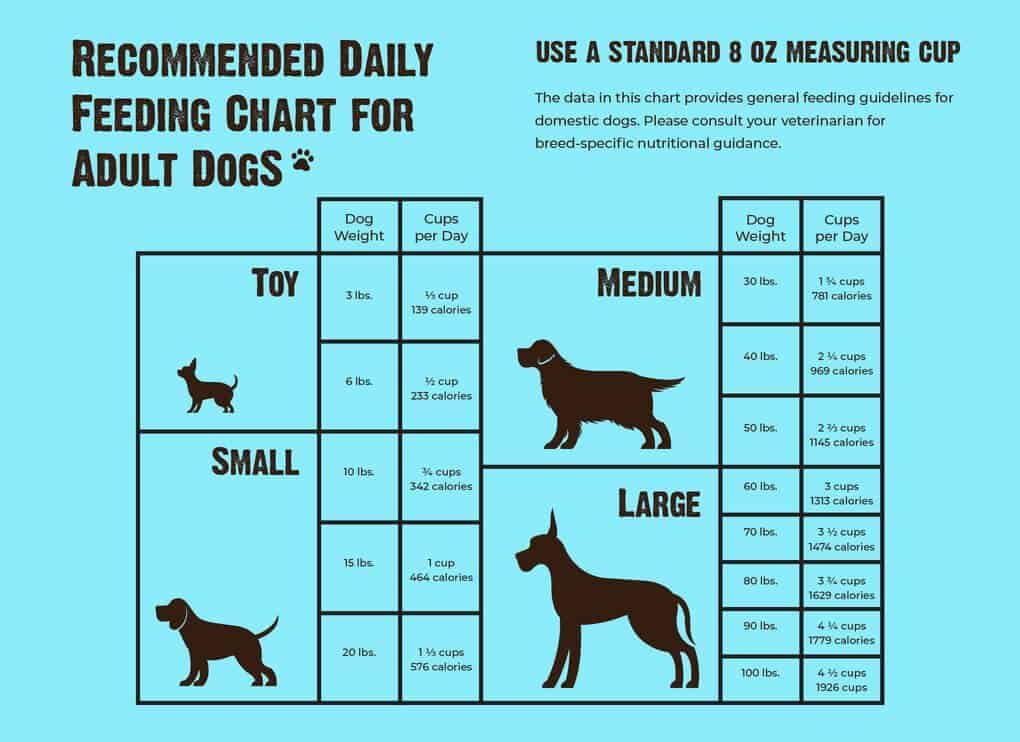
3. Weigh portions.
Adult dogs need to eat around 3% of their body weight per day to stay healthy. Use this helpful feeding chart when measuring portions.
4. Serve whole cuts of meat.
No need to cut their meat into small bites — tearing into larger pieces of meat will help keep your dog’s teeth clean and make feeding a more active pursuit. (Smaller dogs may require smaller pieces of meat.)
5. Prepare fruit and vegetables correctly.
While blended, raw produce is great, you may also steam fruits and vegetables to aid in nutrient absorption and make them easier to digest. Avoid produce that could be harmful to dogs, such as avocadoes, onions or grapes.
6. Restrict starch.
Potatoes and rice are fine in small doses, but too many starch- and carb-heavy foods aren't particularly beneficial to your dog, since they may lead to weight gain.
7. Limit fat intake.
Too much fat can also lead to weight gain and digestive troubles. Limit dairy and fish to small portions or once-a-week feedings.
8. Don’t forget the calcium!
The “B” in BARF stands for “bones,” which will be your dog’s primary source of calcium in this type of diet, but many animal proteins and vegetables are also rich in calcium. You can even add eggshells to their bowl for extra calcium to maintain bone and dental health.
9. Store food correctly.
Raw foods must be kept between 32° and 42°F to avoid spoiling. Keep foods tightly sealed and frozen until ready to serve, at which point you can defrost small amounts in the refrigerator or at room temperature.
10 Monitor your dog’s stool.
Stool that is too soft could indicate that you need to adjust the portions or ingredients in your BARF meal plan. Small, solid stools are ideal.
11. Stick with the diet.
Disruptions to a dog’s diet can cause some unpleasant symptoms, such as itchy skin or abnormal bowel movements. Adjust portions or ingredients as necessary to remedy these, but don’t give up on the diet altogether. Your dog’s body just needs time to adjust.
Before making any major changes to your dog’s diet, be sure to consult with a nutrition-focused veterinarian. You want to make sure you don’t exacerbate any underlying health issues with an abrupt change in diet. You can always feed your dog a combination of raw and minimally processed dry formula, such as RAWZ Meal-free Salmon, Dehydrated Chicken & Whitefish Recipe to ensure they get complete nutrition.
The BARF DIET Grocery List
Ready to introduce your dog to a BARF diet? Follow these recommendations for a balanced bowl. And don’t be afraid to mix it up for variety, or to see what your dog likes best!
Proteins
Fresh, raw, lean cuts of high-quality muscle meat (on or off the bone):
Beef
Chicken
Pork
Rabbit
Turkey
Organ meats
Liver
Kidneys
Raw meat bones (never cooked)
Whole
Ground (can be easier on a dog’s teeth and digestive tract)
Dairy
Cottage cheese
Plain yogurt
Raw eggs
Fresh fish (not more than once a week)
Salmon
Tuna
Whitefish
Fresh PRoduce
Raw vegetables
Broccoli
Carrots
Celery
Pumpkin (fresh or canned — NO pumpkin pie filler)
Spinach and other leafy greens
Squash
Raw fruit
Apples
Blueberries
Cranberries
Fresh herbs (not dried)
Basil
Oregano
Parsley
Avoid these produce items:
Avocados
Grapes
Onions
Garlic
Raisins
Possible Additions, IF Needed
Added moisture
Milk
Vegetable or bone stock
Water
Grains
Barley
Flax
Supplements
Fish oil
Kelp
Vitamin E
Zinc
BARF Feeding Ratio Guidlines
When planning out your dog’s meals for the week, use this feeding chart to create ideal portions.
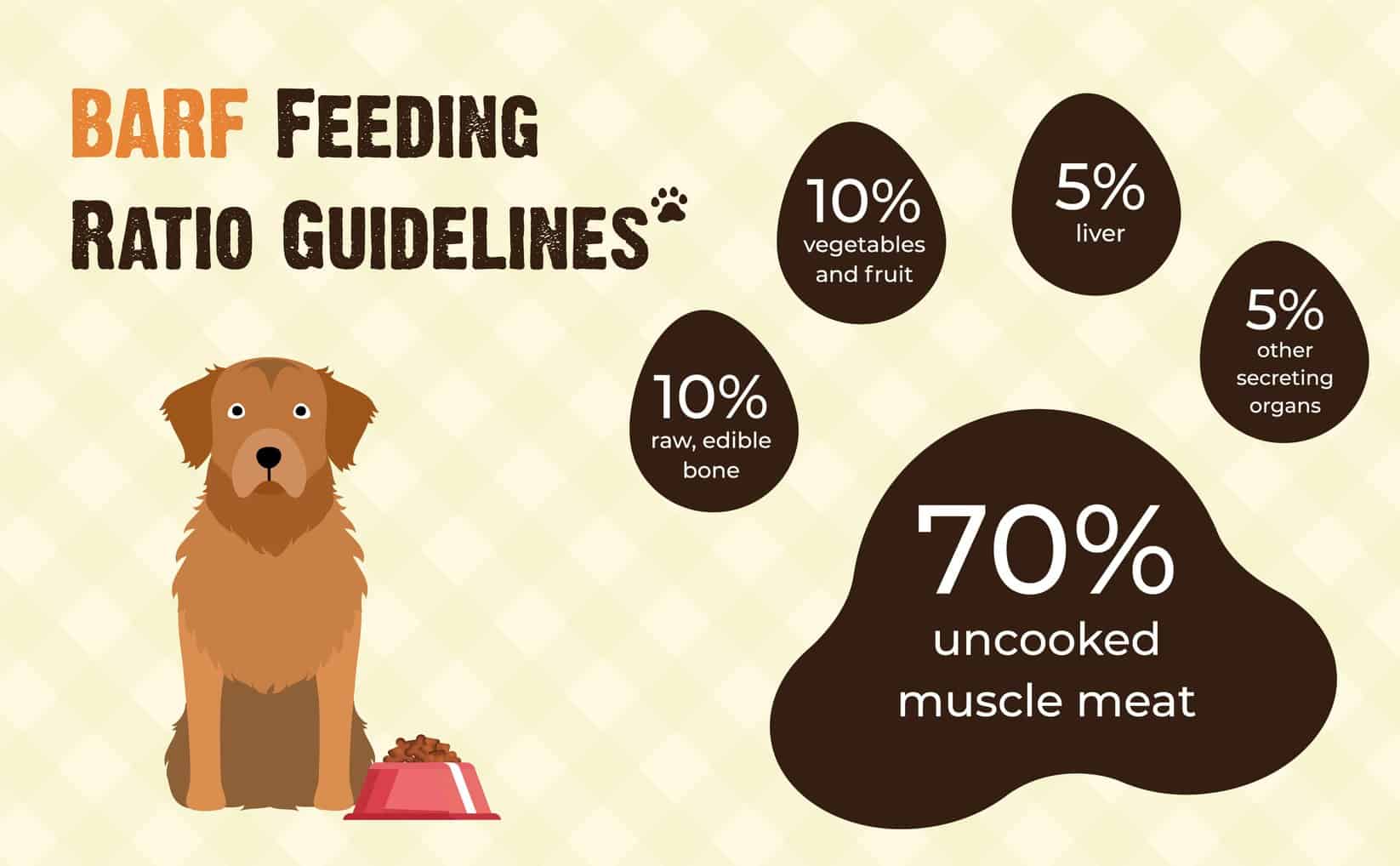
What Do Experts Say ABout The Barf Diet
There are a lot of opinions out there about a raw diet for pets, but there’s also a lot of research.
Dr. Peter Dobias, DVM is an animal health expert and proponent of a raw diet in place of a carb-heavy, kibble-based diet. “When dogs eat large amounts of fiber, grain and complex carbohydrates, they can’t digest these properly,” says Dr. Dobias. “This makes their feces large with [a strong] odor. The feces from a processed food-fed dog is three times larger and if you can’t see it, you can definitely smell it.” Now that’s not a pleasant experience for anyone.
Some animal nutrition experts believe the benefits of a BARF diet extend beyond the digestive tract. Dr. Michael Dym, DVM is one veterinarian who sees a marked improvement in behavior following the switch to a BARF diet. “Holistic dog food” — a popular phrase in the industry — “means food that nurtures the mental, emotional, and physical bodies of our animals with as fresh and varied ingredients as possible,” Dr. Dym says. “This means the foods are minimally processed, which is in contrast to most commercial dog foods that leach out many critical ingredients, include cheap protein sources, and use toxic preservatives to increase shelf life.”
Many veterinarians and animal researchers — like Dr. Anna Hielm-Björkman, DVM of the University of Helsinki and Dr. Karen Becker, DVM of Healthy Pets — point to reduction in allergies and inflammation as one of the most important effects of a raw diet. “Raw food is healthier because it contains thousands more bioactive factors than processed food, in which they have been destroyed by heat," says Dr. Susan G. Wynn, DVM, a board-certified veterinary nutritionist. "Many of these bioactives can reduce inflammation, and suppress damage to DNA.” Though this is happening at a molecular level we can’t see, the effect is evident in our dogs’ shinier coats, fewer digestive issues and increased overall energy.
FAQs About BARF Diets For Dogs
What does BARF stand for?
BARF stands for “biologically appropriate raw foods,” or sometimes “bones and raw foods.”
Is the BARF diet safe for dogs?
As long as dog parents take the proper precautions, the BARF diet is very safe for dogs. However, pet owners should be aware of the risk of improper food storage, cross-contamination from raw meat, and bones that are too large or soft. Time and attention is also required to ensure your dog is getting all the nutrients they need from their meals, so make sure you can dedicate the time and effort it takes to provide them with complete nutrition.
How do I start my dog on a BARF diet?
Slow and steady is the key. Start incorporating a small amount of raw food into your dog’s usual diet, gradually increasing the ratio over 7–10 days. By the tenth day, your dog should be eating their new diet.
Do I have to feed my dog all raw foods on a BARF diet?
No, you do not have to stick to a strict all-raw diet. If you’re budget-conscious or short on prep time and storage space, you can incorporate minimally processed, nutritionally complete formulas to your dog’s raw food. In fact, with a complete nutritional profile, adding in a scoop of RAWZ original or Limited Recipe dry food will ensure your dog gets all the nutrition they need from their meal.
